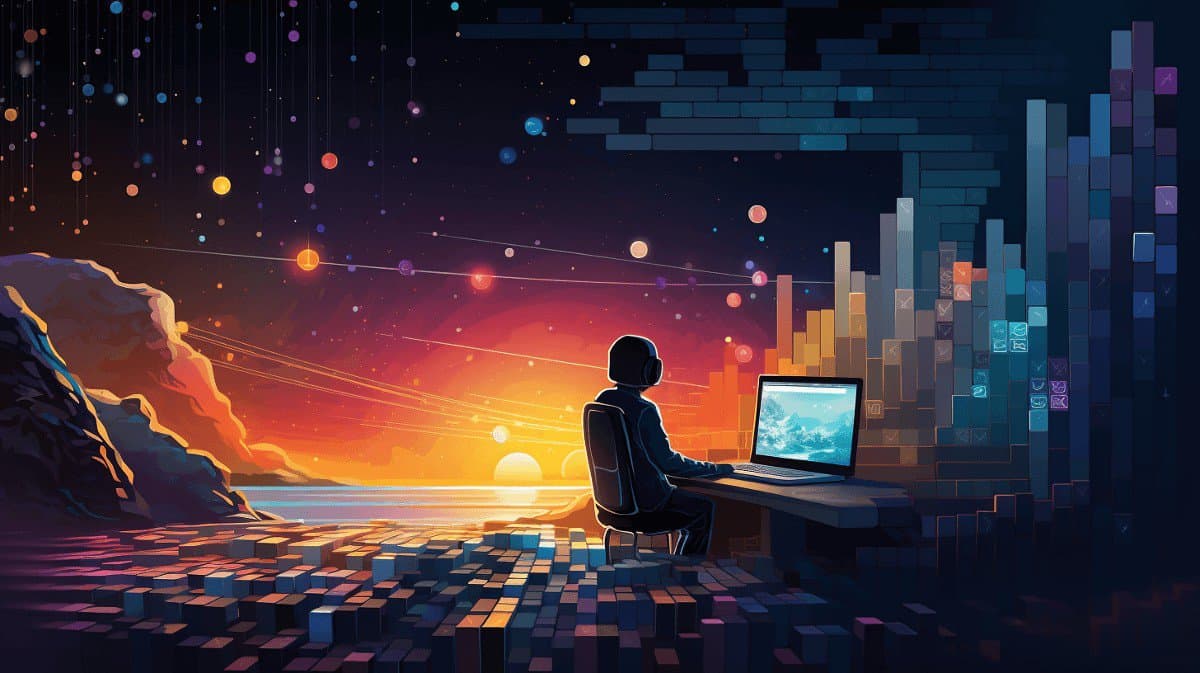AI is becoming more prominent in astrophotography, from AI image-processsing software to AI astrophotography art.
But what about using ChatGPT for astrophotography?
ChatGPT is predominantly a text-based chatbot where you ask questions and have a dialogue with its artificial intelligence. Therefore its use for astrophotography doesn’t seem obvious.
But I tried a number of ways to see if it was any good for helping me with various aspects of astrophotography. Some it did well, some not so well!
Read on to find out what works and what doesn’t work.
1. Planning Targets for Astrophotography with ChatGPT
The first thing I tried was to ask it to recommend to me astronomical objects that I could go out and photograph tonight.
The verdict? Not great.
I asked it to tell me what would be in the sky above me from Boulder, Colorado tonight and instead of giving me accurate information, it just gave me a generic list saying things like:
- “The Moon is a readily accessible target for astrophotography”
- “Planets like Jupiter and Saturn can be excellent targets for astrophotography”
- “If there is an ongoing meteor shower, such as the Perseids or Geminids, you can try your hand at capturing meteors streaking across the sky.”
See here:
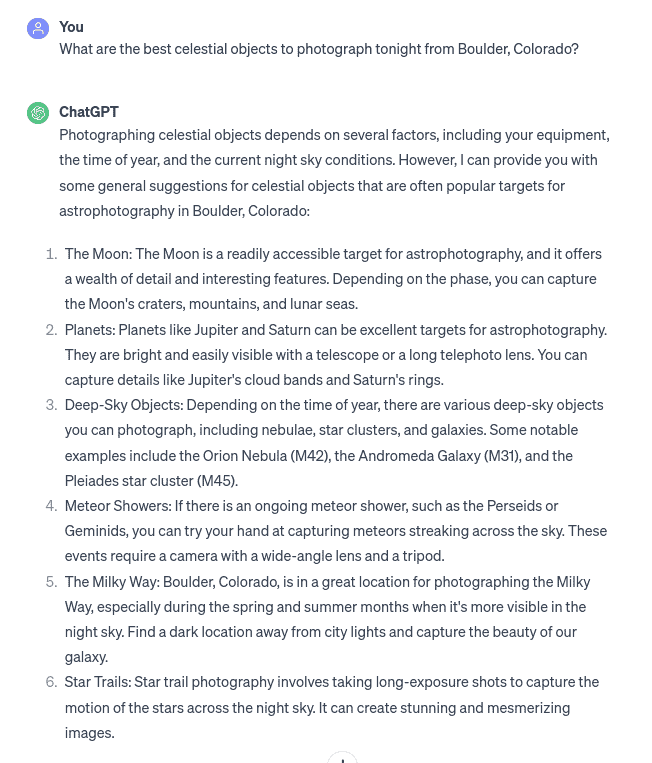
When I asked what exactly would be in the sky above me tonight it confessed to not having access to real-time data like this. Instead it actually recommended a number of astrophotography apps:
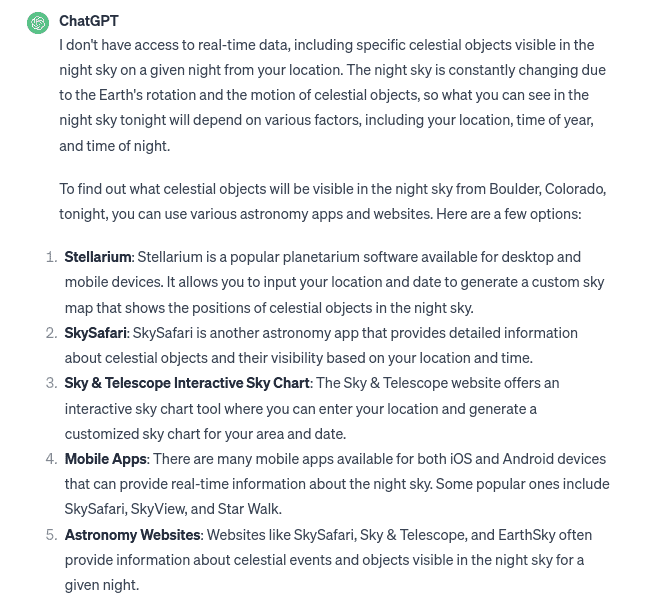
We have a guide to What’s in the Night Sky Tonight from My Location that suggests good sources like Stellarium for this.
So how about if I directed it to use Stellarium to bring back this information for me?
The verdict? It could not access and read Stellarium on my behalf:
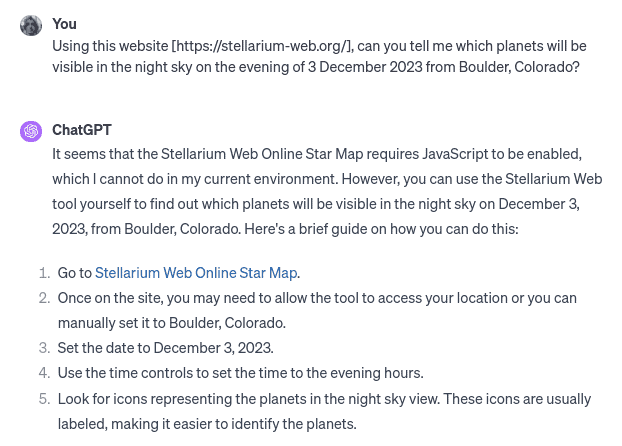
I also asked it to try The Sky Live and In The Sky and the answer was the same.
However, this seems like a technical issue to me (requiring Javascript to be enabled) that might be able to be resolved in the future and so this is something to come back to another time.
What it could do though is give me a quick summary of annual astronomical events. For example, I asked it what meteor showers will occur in 2024 and it gave me this response:
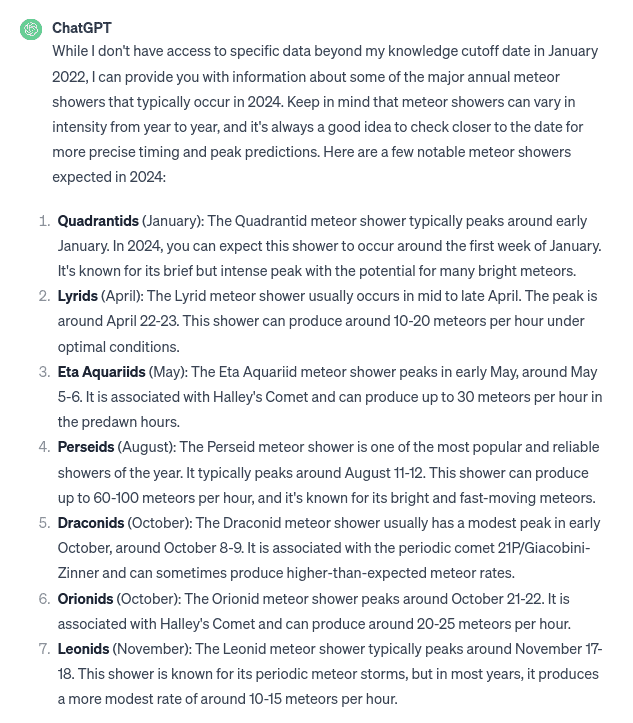
2. Checking the Astrophotography Conditions with ChatGPT
So not having real-time data would also mean it cannot give the weather forecast?
Actually it could. It went off and checked a few weather websites and came back with this:
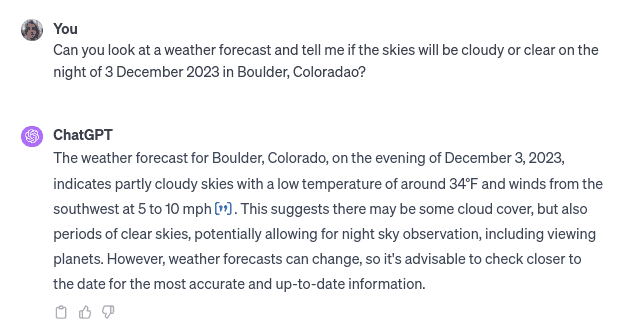
And similar when I asked it for information on the moon phase it was able to provide me with this:
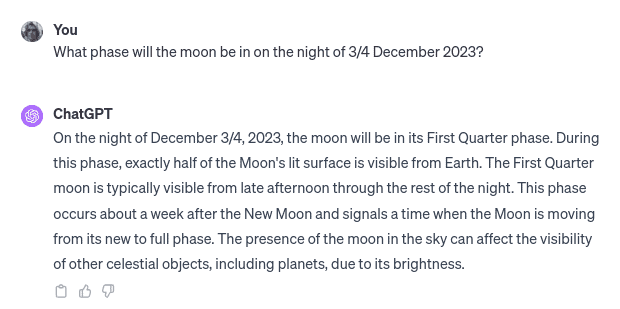
And it could tell me when the next new moon phase would be:
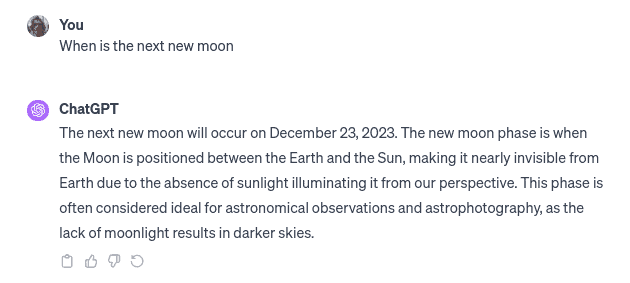
So the verdict here is quite good.
3. Finding Dark Skies with ChatGPT
How about asking it to find me some dark sky locations to get away from light pollution?
It gave me some good ideas:
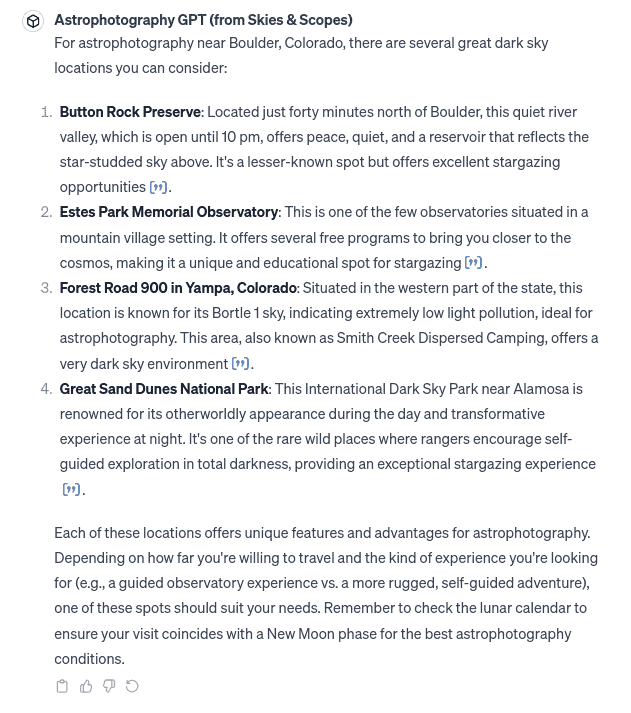
4. Calculating Astrophotography Settings with ChatGPT
In theory, ChatGPT should be good at doing anything quantitative and so giving advice on settings to use might play to its strengths.
I started by asking it if knew the NPF rule for astrophotography (note, I started asking it to keep responses brief as otherwise it tends to go on a but much):
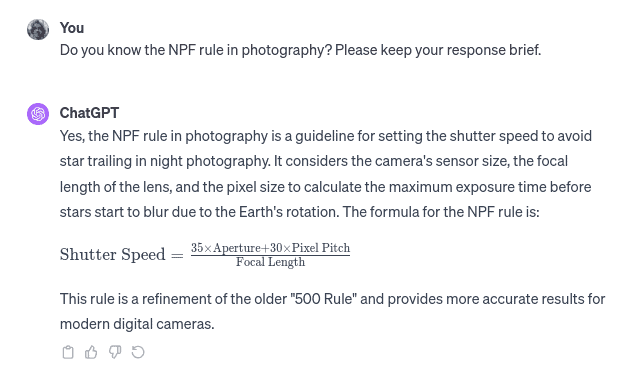
So far, so good. It knows the rule and seems to understand what it’s for and how it works.
I then asked it to calculate my recommended exposure time with the NPF rule using a Canon EOS 6D DSLR camera (note, I picked an older model so it shouldn’t have a problem with needing more recent data), with a 14mm f/2.8 lens. This is what it gave me:
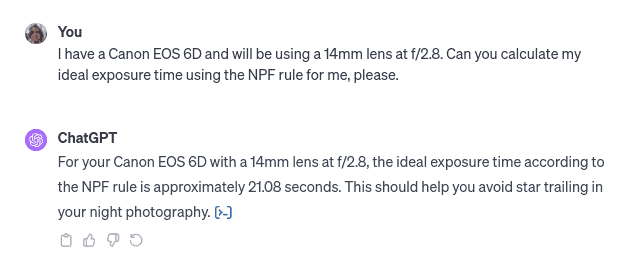
This is pretty good. It says 21 seconds, according to the NPF rule tool on the PhotoPills app it should be 19.7 seconds:
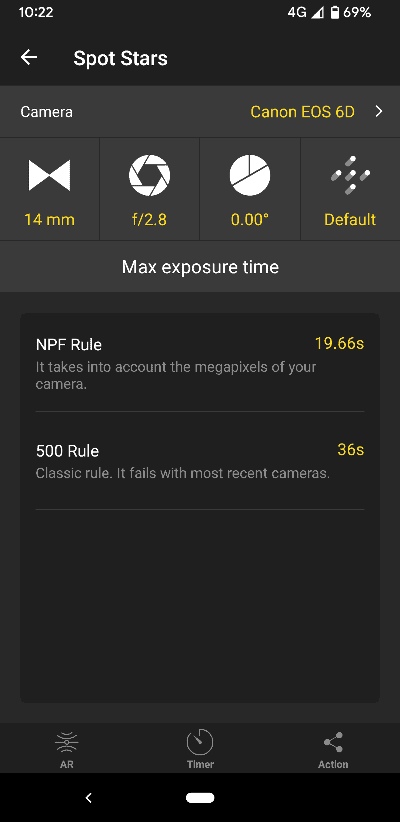
I’m actually not sure which one is strictly the most accurate (probably Photopills) but it’s close enough not to matter and you’d be going for a 20 second exposure time based on either of these.
Therefore is this an example of ChatGPT helping for astrophotography? In theory yes, but actually the first time I asked it the same question with a slightly different wording it was actually wildly wrong and recommended I go for 176 seconds:

I’m not sure why specifying a Rokinon lens with the same attributes caused it to be so wrong!
Therefore there’s a bit of a trust issue here. I know I can ask it this sort of thing but I’d have to have at least a rough idea in my head of what it should be to know whether it is right or not. If I have to check it in another calculator then it’s not really worth it.
5. ChatGPT Astrophotography Equipment Suggestions
I wondered whether it could give advice on what equipment I might want to buy or use, so I asked for its advice on choosing a camera for landscape astrophotography:
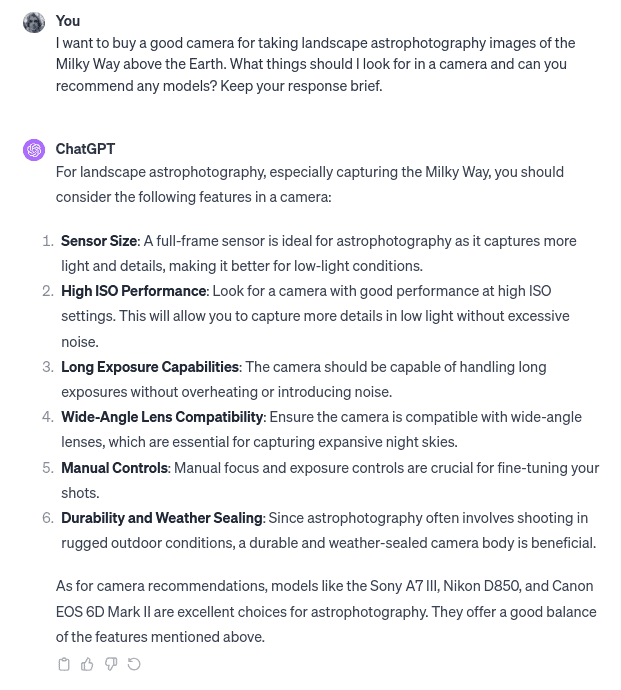
I’d say this is actually not bad. The recommended camera models at the end are a bit random and there’s no real reason for it picking them over others but there’s nothing actually wrong there.
However, I’d say this is something that not many of us are going to use AI for. Buying gear like a camera or telescope is such a personal choice that most of us prefer to get recommendations from individuals that we trust. (Incidentally, you can head here to find the best advice on the best cameras for astrophotography!)
6. ChatGPT Teaching You How to Use Astrophotography Equipment
Now say, for example, you have a Dwarf 2 Smart Telescope and you want to learn how to use it but you don’t have hours to watch video tutorials or written guides.
One thing you can do is ask ChatGPT to summarize a video so that you get the information much more quickly (remember that YouTube videos are often made to keep you watching for as long as possible and show you ads, not necessarily provide the information concisely).
Let’s take this video from our friends at the excellent ScottCAstrophotography channel. It’s just over 17 minutes long (which isn’t actually that long):
Firstly, ChatGPT cannot watch the video but what we can do it provide it with the transcript to analyze:
- Paste the url of the video into a tool like YouTube Transcript
- Copy and paste the transcript into ChatGPT and ask it to summarize
When I first just asked it to summarize the video, the response it gave me was not good at all (it was more like an outline of what was covered in the video). But after a bit of back and forth, I was able to get a good answer by refining my prompt.
It’s too long to post in full, but here’s the start:
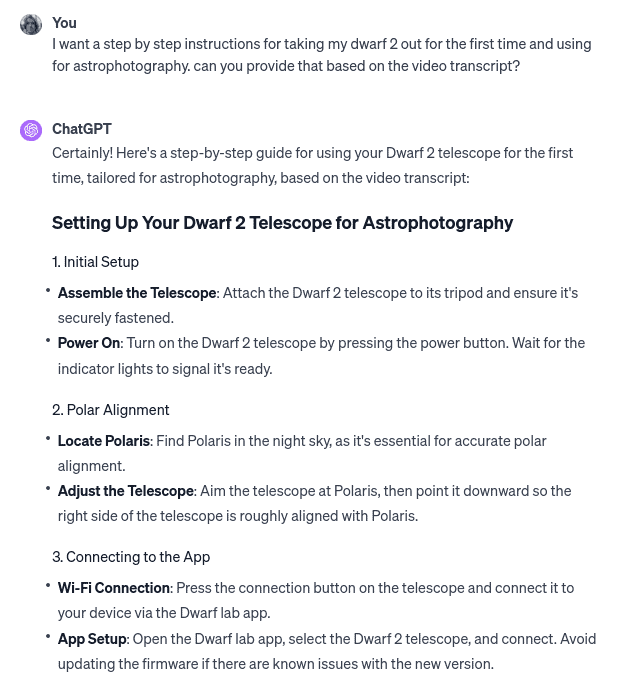
Therefore sometimes it is not that ChatGPT is good or bad, but it often just needs to be asked the right questions.
Think about what you can do with this method to help you learn aspects of astrophotography and image-processing. Sitting through long videos isn’t for everyone and this is a great way of boiling down the key points of steps to follow.
7. ChatGPT Teaching You How To Use Astrophotography Software
Similar to the above, you might be a beginner with astrophotography software like PixInsight and are overwhelmed by the volume of written and video tutorials out there and don’t know where to start.
I presented ChatGPT with this scenario:
I have captured an astrophotography image where I want to reduce the prominence of the background stars in order to make the nebula pop more. Can you tell me how to do this using the astrophotography image processing software PixInsight?
The response it gave me was pretty good. You can see the start of it here:
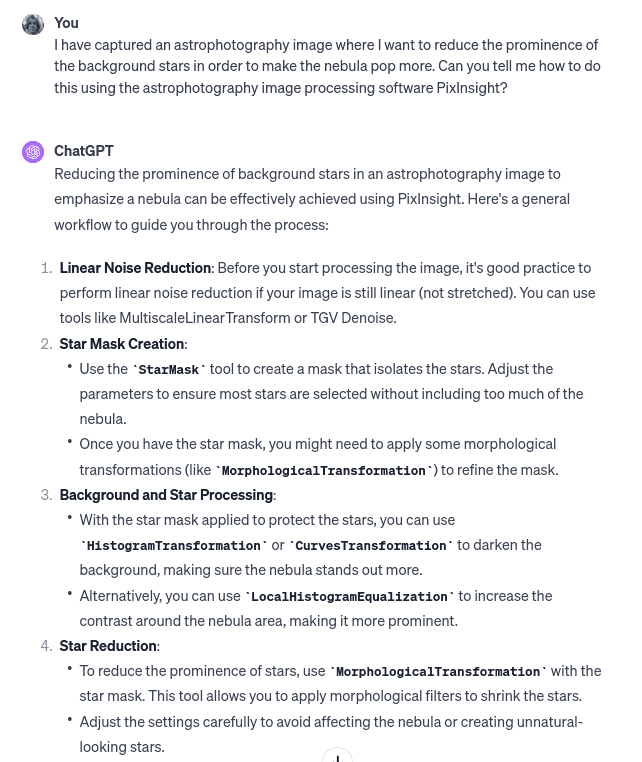
This, to me, is extremely useful. Whilst YouTube videos are great for sharing knowledge and expertise, following tutorials for something like this can involves a lot of flicking between screens and pausing and restarting whilst you try and follow the instructions. Having it written as a list can be really helpful.
Therefore, this is a great example of where you can be very specific with ChatGPT and it can be extremely helpful for astrophotography (or whatever else you might want to present it with).
8. ChatGPT Astrophotography Image Sharing Advice
Sometimes you might have great image but are not so good at selling yourself with a great title or description. Can we get ChatGPT to help with this?
I asked it to give me a caption I can use on Instagram and prompted it to ask me for what information it needed:
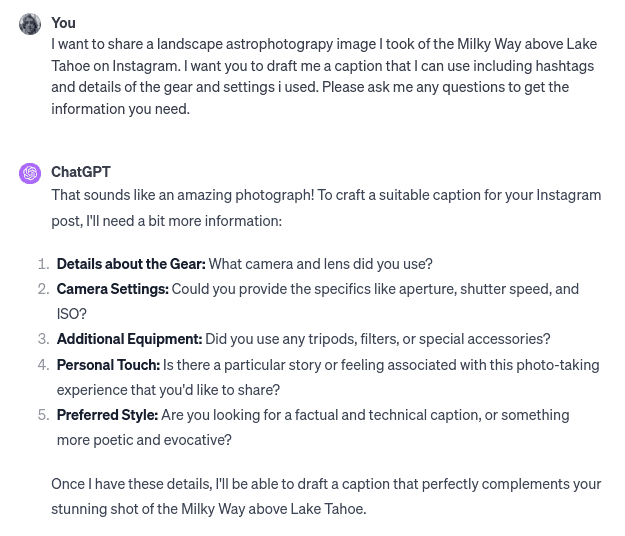
When I replied with all the info, this is what it gave me:
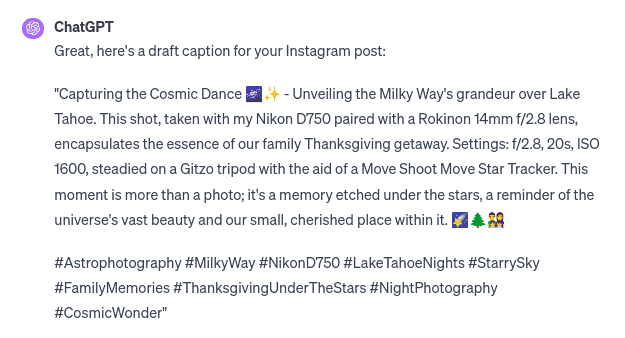
This is pretty awesome. I’m often struggle to write good captions and this seems like a good way to at least give you a first draft.
You could obviously also apply this to any social media or image sharing platform like Facebook, X/Twitter, Flickr, Astrobin etc.
Similarly if you run an astronomy club or anything similar, you can use prompts like this to get ChatGPT to draft communications for you.
Other Ways to Use ChatGPT for Astrophotography
Here are some other ideas on how to use ChatGPT for astrophotography:
- Understanding astronomical objects and events: Since we know that ChatGPT doesn’t have real-time data, but it does have good historical data, so something that it should be good at is providing quick overviews of astrononimical events or objects. For example, I asked “What is the The Pleiades (M45)?” and what it gave me was pretty good. Although it’s nothing you couldn’t get from Wikipedia it was well presented and easy to read, and it’s definitely better than what you would get from just Googling the same question.
- Troubleshooting Equipment or Software Issues: If a user is facing issues with their astrophotography images, like tracking errors or focus problems, ChatGPT could offer troubleshooting tips. Following the examples above, if you can find the right video, or even written guide, you can use it to present the advice in a more concise maner.
- Composition Tips: ChatGPT could offer advice on how to compose astrophotography shots creatively, considering factors like foreground interest and sky movement.
- Project Ideas: Suggest unique astrophotography projects, like capturing the movement of celestial objects over time or experimenting with different photographic techniques.
- Drafting Messages to Lawmakers to Urge Action on Light Pollution: Bit of a tangent this, but it’s inspired by this post on Cloudy Nights where a user shared two prompts that people could take to ChatGPT to quickly generate their own letters/emails relating to the problem of light pollution to go to their local congressional representative and to media outlets like the New York Times. The idea being that while you can just ask people to write letters like these themselves, you are likely to get a lot more support if you make it as easy as possible for others to take action. Giving people the prompt that they can just copy and paste into ChatGPT and then into an email takes a lot of the effort out of trying to motivate others.
- Resources for Further Learning: It can provide recommendations for books, online courses, and communities for enthusiasts to deepen their astrophotography skills. See here for example (you also could dig deeper with prompts relating to the specific gear or software you are using, or type of objects you are photgraphing):
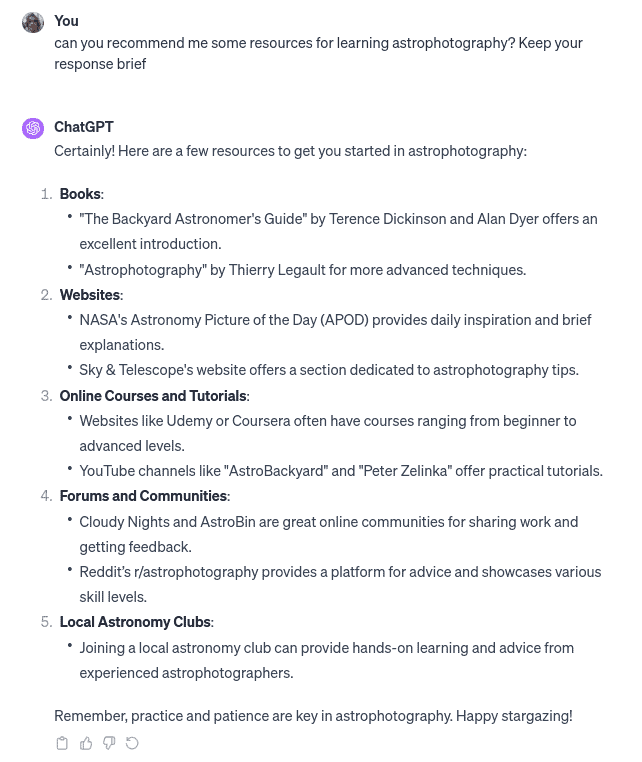
How do you use ChatGPT for Astrophotography?
I hope you found this useful and interesting. I think I learned that ChatGPT can be very good when you give it a very narrow set of circumstances to work with and persist with wording your prompts.
What it is less good at is anything that involves real-time data or product recommendations as it just doesn’t have the subjective knowledge.
We have also created an Astrophotography GPT which you can play with.
The idea is that we have created a version of ChatGPT that knows where to look for good astrophotography advice, rather than plucking random sources.
It can give you information on the upcoming night sky conditions, calculate your exposure time, find dark skies, draft Instagram captions for you. Give it a try and let me know any feedback!
I am also interested in other ways you may have successfully or unsuccessfully used ChatGPT as part of your astrophotography workflow. Please let me know any examples and cases in the comments below (or by emailing me directly) and we can incorporate into this article.


